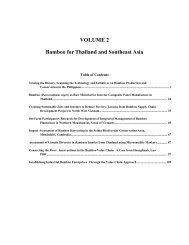WBC-VIII-Vol.4 – Resources – Forestry, Plantations and ... - BambuSC
WBC-VIII-Vol.4 – Resources – Forestry, Plantations and ... - BambuSC
WBC-VIII-Vol.4 – Resources – Forestry, Plantations and ... - BambuSC
Create successful ePaper yourself
Turn your PDF publications into a flip-book with our unique Google optimized e-Paper software.
sequester carbon, can be an effective, cheaper, <strong>and</strong> income generating option to face the challenge of climate<br />
change <strong>and</strong> to fulfill the dem<strong>and</strong> of livelihood for the forest dependent people. Out of few big bamboo species,<br />
which are able to grow at lower temperature, Dendrocalamus asper is one of the economically viable <strong>and</strong><br />
socially useful species for cultivation in the mid hills of Himalayan region. No reports on biomass produced by<br />
D. asper are available from the mid hill region of India. The Present study was conducted to estimate the above<br />
ground biomass produced in D. asper plantation at two aspects (hill slope <strong>and</strong> river side) in the mid hills of<br />
Uttarakh<strong>and</strong> state of India.<br />
Materials <strong>and</strong> Methods<br />
The study was conducted during 2006-2008 at Agriculture Research Station, Majhera <strong>and</strong> Jarmila, Garampani,<br />
Nainital, Uttarakh<strong>and</strong>, India. Altitude, latitude <strong>and</strong> longitude of the study site are 1000 m (a.s.l.), 29º30.137’,<br />
79º28.784’, respectively with two aspects i.e. top of hill <strong>and</strong> side of river bank. Maximum temperature,<br />
minimum temperature <strong>and</strong> maximum relative humidity were recorded 32.1ºC in the month of June, 4.83ºC in the<br />
month of January <strong>and</strong> 97.67 per cent in the month of August, respectively on the basis of mean of three years<br />
data. Annual rainfall of this site was 554.30 mm (Fig 1).<br />
Methods as given here pertain to data collection procedure <strong>and</strong> analysis for biomass using acceptable linear<br />
equations for the encountered species in this study. Plants of D. asper were produced through micropropagation<br />
(Agarwal et al. 2008) <strong>and</strong> planted at ARS, Majhera at the top of the hill <strong>and</strong> at Jarmila by the side of the river<br />
bank of Kosi (spacing 5m) in the year 2006 (Fig 2). Sampling was done during December 2008 by selecting five<br />
plants from each site. Five poles of various diameter <strong>and</strong> height from each plant were harvested. Fresh weight of<br />
each pole with branch & leaves was taken <strong>and</strong> dry weight was recorded by drying at 70ºC for 72 hrs in an oven<br />
after harvesting. On the basis of fresh & dry weight linear regression equation was developed (Singh et al. 2009)<br />
to estimate the above ground biomass of D. asper. For the estimation of soil carbon, sampling was done<br />
according to Jackson (1973) at 0.5m <strong>and</strong> 1.0 m radial distance from the centre of the plant. Soil sampling for<br />
control was done before the bamboo plantation. Estimation of organic carbon was done by Soil testing<br />
laboratory (Uttarakh<strong>and</strong> Tea Development Board), Bhowali, Nainital (UK) India.<br />
Results & Discussion<br />
Model for the prediction of above ground biomass in D. asper was developed. With the help of this model,<br />
estimation of above ground biomass produced by D. asper at two aspects in the mid Himalayan region was<br />
done. The results indicated change in the biomass on the basis of fresh <strong>and</strong> dry weight. For fresh weight, height<br />
of the pole, girth to height at 1.0 m <strong>and</strong> 1.5 m affected the biomass by 99.8 per cent whereas in dry weight it was<br />
97.6 per cent (Table 1).<br />
<strong>VIII</strong> World Bamboo Congress Proceedings Vol 4-91




